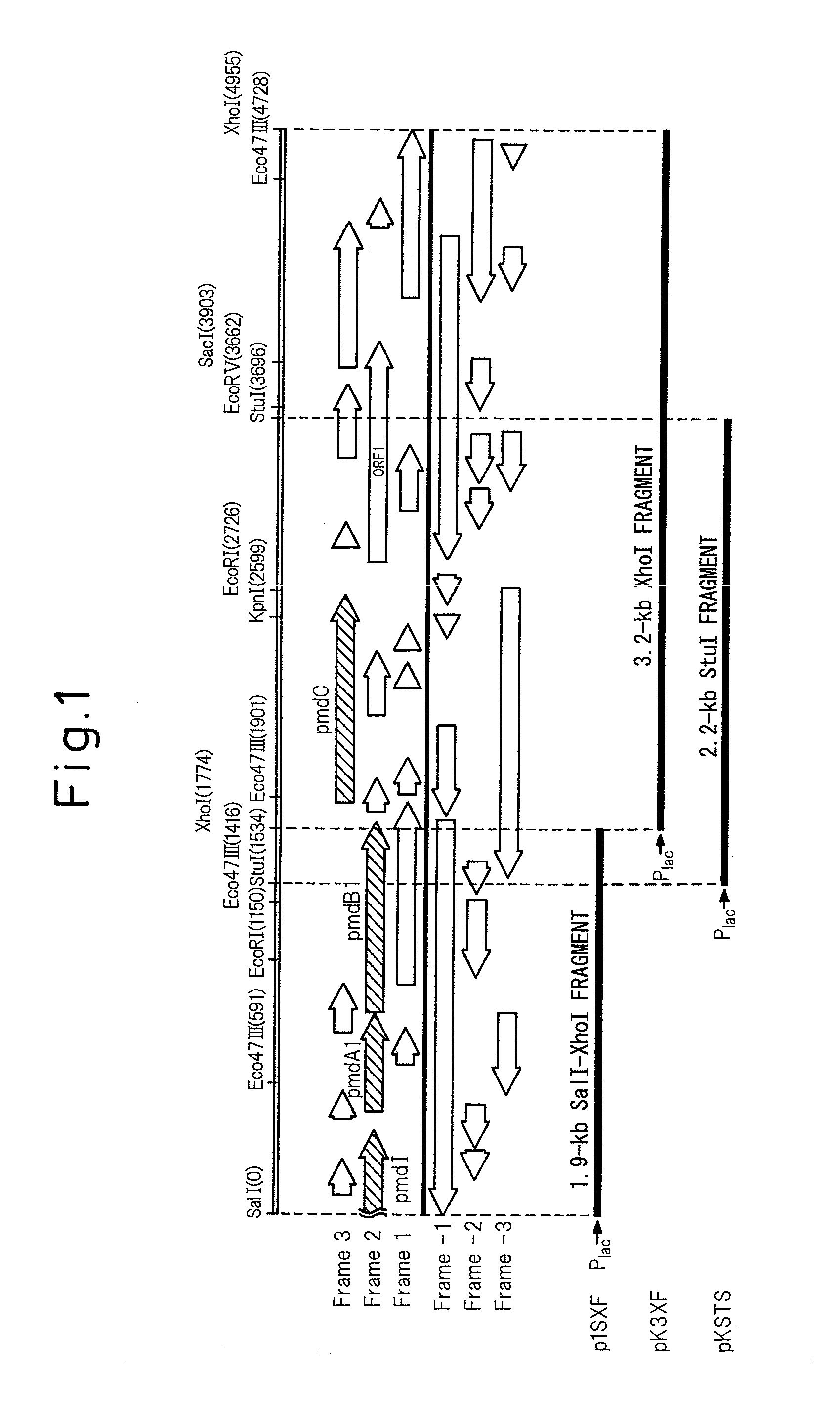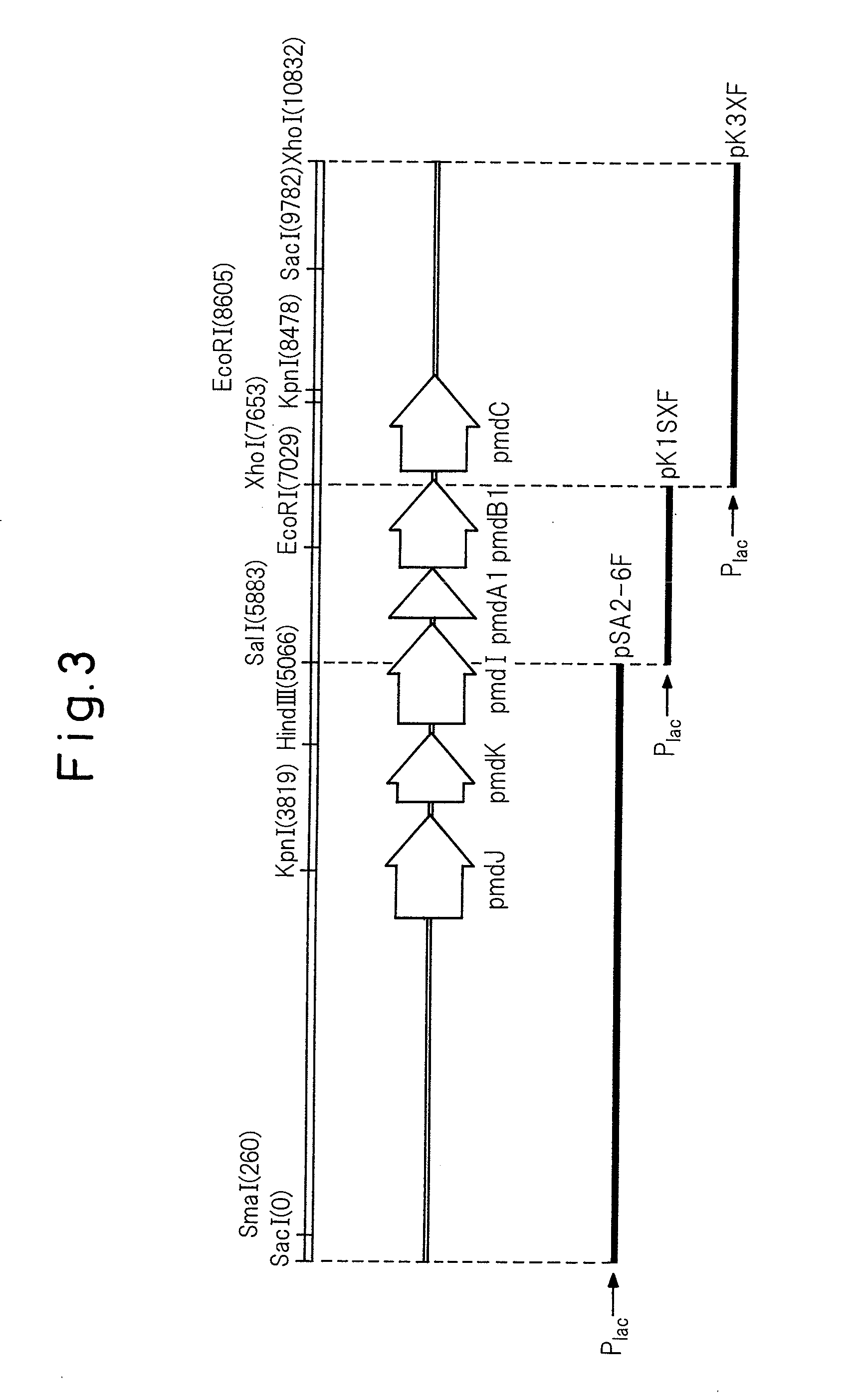Gene-disrupted strain, recombinant plasmids, transformants and process for production of 3-carboxymuconolactone
a technology of genedisrupted strains and transformants, which is applied in the field of genedisrupted strains, recombinant plasmids, transformants and process for the production of 3carboxymuconolactone, can solve the problem that no process has been known to date for fermentative production, and achieve the effect of high yield and inexpensive fermentation production
- Summary
- Abstract
- Description
- Claims
- Application Information
AI Technical Summary
Benefits of technology
Problems solved by technology
Method used
Image
Examples
example 1
(1) Amplification of Protocatechuate 4,5-Dioxygenase Gene by PCR and Sequencing
[0065]A region of high homology was identified from alignment of the amino acid sequences deduced from the ligA gene of Sphingomonas paucimobilis SYK-6, the pcmA gene of Arthrobacter keyseri 12B, the pmdA1B1 gene of Comamonas testosteroni BR6020 and the fldVU gene of Sphingomonas sp. LB126, and PCR was conducted using the following αF / βR primer, with the total DNA of the Comamonas sp. E6 protocatechuate 4,5-dioxygenase gene as template.
αF of α-subunit(26 mer:ATGWSSCTGATGAARSCSGARAACCG; SEQ ID NO: 5)βf of β-subunit;(27 mer:GTSWTCCTGGTSTAYAACGAYCAYGCY; SEQ ID NO: 6)andβR of β-subunit.(25 mer:CCCTGMARCTGRTGGCTCATGCCGC; SEQ ID NO: 7)
[0066]As a result, amplification was seen at the predicted size of 900 bp. The PCR product was then used as template for PCR between βF-βR, using the nested primer βF. As a result, amplification was seen of a 450 by fragment of the predicted size. The obta...
example 2
Construction of pmdB1 Gene-Disrupted Strain
[0070](1) Preparation of pmdB1 Gene-Disrupting Plasmid
[0071]A 3.6-kb SalI-EcoRV fragment containing the pmdA1B1C gene was cut out from pKS10F and inserted into a SalI-EcoRV digest of pBluescript II KS(+) to obtain pSDB36. It was then digested with StuI within the pmdB1 gene, and a 1.2-kb EcoRV fragment containing the pIK03-derived kanamycin resistance gene was inserted therein (the underlined portion of the sequence of SEQ ID NO: 1). Insertion of the fragment in the same direction as the pBluescript II KS(+) lac promoter transcription direction was confirmed by SmaI digestion, thus obtaining pKS78F. A 4.9-kb SalI-EcoRV fragment was cut out from pKS78F and inserted at the SalI-SmaI site of pK19 mobsacB to construct plasmid pDBKM for generated of a pmdB1-disrupted strain (FIG. 4).
(2) Construction of pmdB1 Gene-Disrupted Strain
[0072]E6 precultured in 3 ml of LB medium was inoculated at 1% into 10 ml of LB medium, for main culturing. After grow...
example 3
Production of 3-carboxymuconolactone
[0075](1) Construction of Recombinant Plasmid pKTphHG / C for 3-Carboxy-Cis,Cis-Muconic Acid
[0076]1-1) A DNA fragment obtained by cutting the recombinant plasmid pBluescript II SK− / pcaHG mentioned in Japanese Patent Application No. 2006-218524 with restriction enzymes pvuII and BamHI and then blunting the ends, and a DNA fragment obtained by cutting pKT230MC mentioned in Japanese Unexamined Patent Publication No. 2005-278549 with restriction enzyme XbaI and then blunting the ends, were ligated with T4DNA ligase (Roche) to construct recombinant plasmid pKHG (FIG. 6).
[0077]1-2) Next, a DNA fragment obtained by cutting chloramphenicol resistance gene-containing plasmid pHSG398 (product of Takara) with restriction enzyme Cfr13I and then blunting the ends, and a DNA fragment obtained by cutting pKHG with restriction enzyme KpnI and then blunting the ends, were ligated with T4DNA ligase (Roche) to construct recombinant plasmid pKHG / C (FIG. 7).
[0078]1-3) A...
PUM
| Property | Measurement | Unit |
|---|---|---|
| voltage | aaaaa | aaaaa |
| resistance | aaaaa | aaaaa |
| volume | aaaaa | aaaaa |
Abstract
Description
Claims
Application Information
 Login to View More
Login to View More - R&D
- Intellectual Property
- Life Sciences
- Materials
- Tech Scout
- Unparalleled Data Quality
- Higher Quality Content
- 60% Fewer Hallucinations
Browse by: Latest US Patents, China's latest patents, Technical Efficacy Thesaurus, Application Domain, Technology Topic, Popular Technical Reports.
© 2025 PatSnap. All rights reserved.Legal|Privacy policy|Modern Slavery Act Transparency Statement|Sitemap|About US| Contact US: help@patsnap.com



